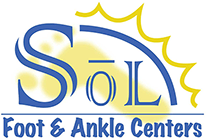
Your feet are your foundation and have the potential to impact your entire body. Flat feet and overpronation are known culprits of foot pain, knee pain, and lower back pain!
If having a stable foundation is the key to everything in life, why do we neglect our feet?
Did you know?
foot pain is a common problem that most people experience during their life? According to a study conducted by the APMA, 8 out of 10 Americans have experienced foot problems and half of all adults say that foot pain has restricted their activities in some way and impacted their quality of life. (2014)
There are many different reasons why you may be experiencing foot pain. Here is a list of common foot problems and what you can do to fix them.
1. Plantar fasciitis – If you have pain in your heel when you frst get out of bed in the morning, or after sitting for long periods of time, chances are you may have plantar fasciitis. The best way to get rid of plantar fasciitis is to wear custom foot orthotics, or arch support insoles, and stretch your calf muscle. If you still have pain after two weeks, visit a podiatrist who specializes in treatments for plantar fasciitis.
2. Worn-out shoes - Wearing worn-out shoes, and or shoes that are too small, can cause heel pain, bunions, corns, and contribute to foot, back, hip, and even knee pain. If you stand on your feet all day, wear shoes that provide arch support and that have a removable footbed so you may add your own orthotic arch support. Look for top shoe brands such as Brooks, Orthofeet, and Apex. Check out our in-office store, Foot Traffik, the One-Stop-Foot-Shop in Long Beach, CA. We carry a wide selection of top-grade OTC insoles, support shoes, and comfort footwear.
3. Stress Fracture – If you have tenderness, swelling, or dull, aching pain in your foot that intensifies with exercise but goes away with rest, you may have a stress fracture. Stress fractures are small breaks in the bone and ignoring the pain may have more serious consequences if left untreated. RICES (Rest, Ice, Compression, and Elevation and Support) should be done immediately, and schedule an appointment to see your podiatrist as soon as possible.
4. Bunions – A bunion, a bony bump at the base of your big toe, can cause pain and swelling making it difficult to walk or wear shoes. Bunions are hereditary but can be brought on by pointy and tight-fitting shoes. Choose to wear wider shoes to reduce the pressure on the bunion, try adding an over-the-counter arch support to your shoes, and talk to your podiatrist about prevention and treatment options.
5. Plantar Warts – Warts on the bottom of your feet can be painful when walking. Plantar warts are highly contagious and can spread to other areas of the foot and to other people. Sol Foot & Ankle Centers’ podiatrists use a special compounded formula to get rid of plantar warts fast and effectively.
6. Tendonitis - Your foot and ankle contain more than 100 muscles, ligaments, and tendons that work together to support and balance your body. Injury, overuse, and poor biomechanics can strain tendons causing inflammation, pain, and stiffness in the feet and ankles. Try RICES and OTC non-steroidal anti-inflammatory drugs to relieve pain. If your pain does not improve after 7 days, contact your podiatrist.
7. Big Toe Pain – Pain in your big joint may be a sign of arthritis. If you have pain in your big toe after exercising or when walking, try wearing a supportive athletic shoe, a stiff-soled shoe, and/or adding arch support.
8. Corns and Calluses – Thick, rough, and dead skin that builds up on your feet can cause pain when walking. Corns and calluses can form where there is friction and repeated rubbing. Shoes that don’t fit properly and are too tight can cause calluses and deep corns between your toes. Try using an OTC pumice stone and or visit your foot doctor that can safely remove deep and painful calluses. *If you are diabetic, consult your podiatrist for regular foot maintenance.
9. Hammertoes – Crooked, bent, and crossed-over toes is a deformity that usually happens over time. Pain may be caused by pressure on the toes or by rubbing against your shoes. Try using hammertoe gel pads and crest pads to relieve pressure, wear soft accommodative shoes, and consult your podiatrist to discuss further treatment options.
10. Ingrown Toenails – Swelling, redness, and pain on the outside of your toenail occur when the nail begins to grow into the surrounding nail fold. The nail can cut deeply into the skin causing infection. Ingrown toenails are best treated by your podiatrist. Try soaking your foot in warm water and Epsom salts to draw out any bacteria and avoid wearing shoes that put pressure on your toe.
If you have any of the above foot problems or have any concerns about the health of your feet talk to a podiatrist who specializes in the health, care, and maintenance of your feet.
Contact a foot and ankle specialist at Sol Foot & Ankle Centers near you in Long Beach, CA. Three convenient locations and Saturday appointments are available.
Q&A
Q: What causes foot pain?
A: Common causes include plantar fasciitis, worn-out shoes, bunions, and stress fractures.
Q: How can I treat plantar fasciitis?
A: Use foot orthotics, stretch your calves, and if symptoms persist, see a podiatrist.
Q: What should I do for worn-out shoes causing pain?
A: Switch to shoes with good arch support and a removable footbed.
Q: When should I see a podiatrist?
A: If foot pain persists or you have specific issues like bunions or tendonitis, consult a podiatrist.
Related Links |

